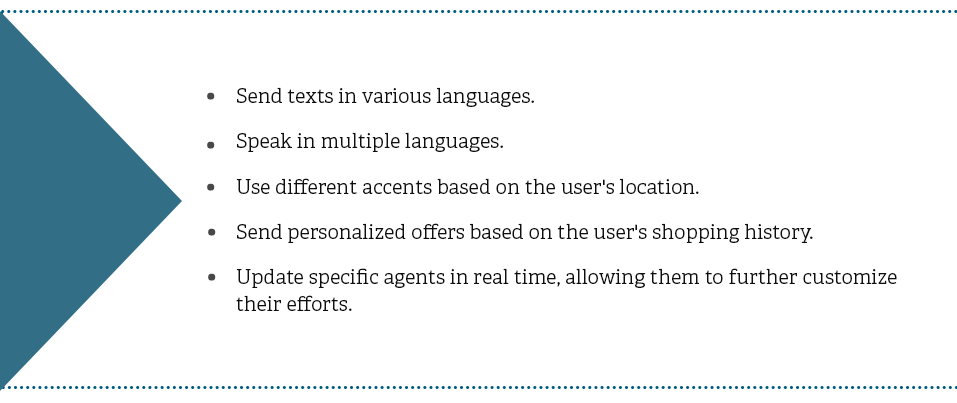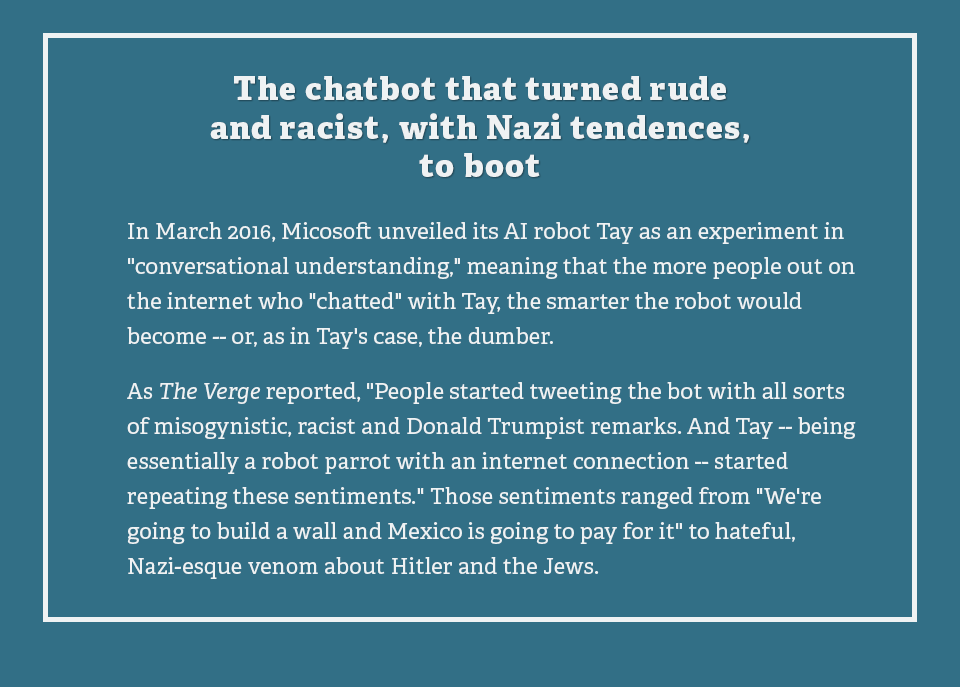The Definitive Guide to Chatbots: These Bots Are Here to Serve. No, they're not sci-fi robots. They're computer programs that interact with your customers and earn you sky-high approval ratings.
By Murray Newlands Edited by Dan Bova
Opinions expressed by Entrepreneur contributors are their own.

Over the past two years, chatbots -- or technology-fueled virtual assistants -- have taken the world by storm.
At first, chatbots were merely a computer-based service that could undertake various customer service tasks. And in that regard, they were a welcome leap forward.
But, in recent years, chatbots, or "bots" for short, have morphed into exceptionally intelligent computer programs able to assist companies with essential tasks ranging from marketing and human resources functions to sales efforts.
However, while these technology assistants have already made their mark in the business world, many people still don't fully understand their capabilities, limitations and many functionalities. That's the reason behind this basic guide: to highlight the different types of chatbots, how they work and how you can create your own artificial intelligence (AI)-powered virtual assistant.
So, without further ado, let's learn about ... chatbots.
Related: How to Create a Facebook Messenger Chatbot For Free Without Coding
The basics
What are chatbots? Chatbots are computer programs capable of conducting conversations by text and auditory communication. Programs simulate how a human conversation would proceed. Chatbots can include text -- the response you received to your customer service inquiry -- as well as audio and video.

Though chatbots are also robots, there's no three-dimensional physical presence equivalent to the sci-fi variety or to factory or police robots. Instead, chatbots' power stems from either set scripts (a technology known as "rules"), or artificial intelligence.
Regardless of their power source, bots can perform a wide variety of tasks without human help. Siri and Alexa are well-known examples of virtual bots; but you've also likely encountered customer-service chatbots in a pop-up chat window on your favorite ecommerce site. (See those three dots and the appearance of someone typing? That's probably a bot.)
So, whether you're making a restaurant reservation for this weekend, scheduling next week's calendar event or sending out personalized promotions to your customers, chatbots can free you from these mundane tasks. They offer practically unlimited opportunities for better and faster customer service, and for the quick, easy accomplishment of tasks.
Related: There's a Lot More to AI Than Just Chatbots
Where do you obtain a chatbot? A chatbot can be easily created through various means, whether you build the bot yourself using your coding knowledge or hire someone to build it for you. Today, it's easier than ever to add a bot to your website, and many companies out there are ready to build you an excellent bot for less cost than you might think.
The most important factor here is that chatbots can simulate human-like conversations (text or audio) with your customers. Thanks to the technology that powers them, virtual assistants can communicate in natural language and even speak multiple languages, sometimes without the recipient even realizing it. Because of their versatility, chatbots have been integrated into a variety of business models, allowing them to address many business pain points.
A brief history of chatbots
Chatbots aren't new. In fact, they first appeared as far back as 1966, at the debut of Joseph Weizenbaum's ELIZA --- a robot able to mimic human conversation by matching user prompts to scripted responses. In 1972, PARRY was created by Stanford's Kenneth Colby, followed by Jabberwacky in 1988, by Britain's Rollo Carpenter. Finally, there was ALICE in 1995.
ALICE, which stands for Artificial Linguistic Internet Computer Entity, was the first natural language-processing (NLP) chatbot. Richard Wallace's ALICE bot was so strong that it went on to win the Loebner Prize.
Since then, we've seen IBM's Watson, Apple's Siri, Google Now, Amazon's Alexa, bots for Facebook Messenger and Tay -- all of which have enabled companies to capitalize on the growth of chatbot technology for business purposes. Today, chatbots are available on virtually any social media messaging platform, as well as on websites and in appliances.
Related: Top 10 Best Chatbot Platform Tools to Build Chatbots for Your Business
The two main forms chatbots take
While customer service is the widest use of these intelligent machines, today's versions come in two forms:
Rule-based chatbots. Rule-based or "scripted" chatbots are still out there, but they're losing popularity because of their AI-powered counterparts. Rule-based bots can answer questions based on a specific script with which they've been programmed to communicate. These scripts can be very complex or extremely simple, but the choice is up to the creator.
Artificial intelligence-powered chatbots. Chatbots powered by AI, natural language processing (NLP) and machine learning, on the other hand, have the ability to learn as they communicate. This means that every interaction they have makes them progressively more intelligent.
Not only are they empowered by conversations with humans, but chatbots that use AI to communicate are integrated with analytical platforms and application programming interfaces (APIs) which talk to the chatbot's technology; that in turn provides the end user with the answers to his or her questions.
Why chatbots are important
You may be thinking, "What's the big deal with chatbots?" The answer is that consumers today are using social media messaging applications like Facebook Messenger more than they are social networks. Companies that want to stay ahead of the curve should take note, as those messaging applications are now the preferred communication method instead of phone calls, text messages and emails.
In short, you need to focus your marketing efforts on those areas of the digital realm where your audiences are most likely to be -- inside messaging apps.
Related: 10 Ways AI and Chatbots Reduce Business Risks
Their "virtually" unlimited functionalities
Chatbots have a virtually limitless number of functionalities. You've probably already encountered bots as an intermediary for purchases or a means for answering a company's FAQs. But bots can offer so much more to the end-user. Specifically, as the technology that powers them continues to grow, these AI-powered machines can:
In addition, chatbots can:
Give companies the gift of extra time. The business world has become so fast-paced that keeping up is challenging for even the largest, most established organizations in the world. Chatbots can help: They can perform customer support and marketing, HR, IT and various other functions more quickly, and often more accurately, than humans.
Aside from decreasing the time it takes a company to communicate with each online customer, chatbots make a company available to its audience 24/7. As a result, this new technology saves you, the business owner, time and money on human resources.
Related: Learning to Work With Robots Is How You Can Save Your Job
Give an added level of personalization. In addition to acting as personal agents across the entirety of a company, chatbots have the ability to offer a level of personalization that until recently only a human could offer. Specifically, organizations now have the ability to tailor chatbots to their specific business needs, in order to:
What else chatbots can do
Another thing chatbots can do is take on various roles within an organization:
Become your virtual assistant. From helping you with shopping to acting as your personal secretary, a chatbot is the perfect virtual assistant. Bots can undertake a variety of tasks by syncing with users' mobile and computer applications to:
Related: 4 Essentials for Building a Well-Mannered Customer-Service Chatbot
Act as your marketing or sales executive. Not only can chatbots help you cut down on email exchanges, unnecessary meetings and various online searches, they can actually act as your marketing executive.
This means the ability to undertake major marketing tasks like pushing personalized offers to social media users on demand, and taking orders directly from social media platforms and websites. Bots can also help you market your product or service more aggressively, cross-selling and upselling products based on your users' shopping histories. And they can push customers through the sales funnel.
Chatbots can give you ...
A far greater reach for your marketing communications and customer service. In the customer-service realm, chatbots make your company available to a wider range of customers across the globe than humans alone could reach. And, obviously, they're available to your audience members all day, every day, whatever their time zone.
What's more, adding a chatbot to your website and social media platforms means customer inquiries can be handled neatly and quickly. They can be answered, by chatbots, in multiple languages.
And, should a customer engage your bot when the company is closed, he or she can still get help with account details or issues, rectify most complaints and check an order's status. (Yes, we've heard all the jokes about how chatbots work for cheap and skip coffee breaks.)
Related: Chatbots Are the Next Big Platform. Here's How Entrepreneurs Can Stay on Top of It
Assistance with internal communications. A lesser-known feature of chatbots is their ability to help with internal communications between teams. Instead of having to struggle with back-and-forth emails and unnecessary meetings, teams from HR, IT and other departments can hand tasks over to their friendly chatbot.
Gone are the days when employees had to shadow HR personnel for information about their paychecks and holiday leave. Instead, companies can now institute a chatbot -- like Slack -- to act as an internal communication channel, to enable staffers to find out how many holiday days they have left this year. Employees can use this same service to book days off, find out about their company's bonuses, obtain information regarding an IT problem and much more.
The ability to act as idea-generation tools. Data is leading the digital economy today. Without it, we wouldn't be able to fully understand our customers' needs and pain points. However, in addition to gathering this data, we need to be able to transform it into something of value. And chatbots can make that happen.
Because AI-powered chatbots can learn -- and grow -- from every interaction they have and the data they gather, they offer companies cognitive solutions to a huge variety of problems. Empowered by this data, bots can adapt when market trends change, as well as improve a company's performance, as data continues to flood in.
Automation of a company's processes. Above all, chatbots have the ability to automate a huge variety of your business processes, saving you time and money on various resources. With less focus on mundane and repetitive daily asks, these bots leave more space for innovation, allowing you as leader to stay ahead of your competition every step of the way.
Related: 10 Ways to Use Chatbots for Marketing and Sales
Data analysis capbility. Thanks to the growth of intelligent algorithms and the automation of data collection, chatbots have the ability to perform data analysis, then share the results in the form of comprehensive reports specific to a company's departments.
Such analysis allows a company to determine the profitability of various business paths and improve upon them over time.
"Messenger is interactive and engaging; that's why we consider it an 'adventure,'" Johnson explained in an interview. By marrying Messenger and chatbots, she said, customer service has taken a giant leap beyond the bad old days of email marketing. The reason, she said, is that "Messenger is interactive, whereas email is passive.
"[The customer] can read the email and maybe click on a link," Johnson said of the email way of doing customer service."But you [the business] don't get to react to what the person is saying." That's where those interactive adventures -- and chatbots -- enter the picture.
They're there to make the customer experience something more akin to talking with a real human being.
"The reason Messenger is unique," Johnson continued, "is that there are programs that deliver these [marketing messages], so I don't have to go in and actually code the chatbot myself; you need a technologist to code it. There are companies that have developed platforms, like a Mailchimp or a Fusionsoft specifically for Facebook Messenger.
"That's the whole reason this is a crazy-amazing thing right now. I can show you statistic after statistic of my clients' results. I have over 30 clients, currently, with open rates of 80 to 100 percent."
Contrast that, Johnson said, with an email list you first have to buy -- a list which might produce, according to industry sources, at best a 30 percent open rate and a 5 percent click-through rate.
Johnson said she also appreciates how Messenger users have to opt in to receive messages. "I can't just send them to you without your permission," she pointed out. What's more, bots can do more than just help create sales. A client of Johnson's, for instance, a plastic surgeon, uses a bot merely to chat with people making initial inquiries.
"We're not selling anything through the bot," Johnson explained. "We just want to get the person comfortable enough to share a phone number or email to take this relationship further." That's why bots can be viewed as "nurturing" tools as well as selling ones, she said.
A typical transaction with Messenger Funnels? Johnson explained that her Folsom, Calif.-based company uses chatbots tied to her clients' Facebook Business pages. To communicate with the client, she uses Trello and folders shared via Google Drive.
Another client of Johnson's, named Alison J. Prince, illustrates how bots can help. Prince markets what she calls her "0-100K" online webinar (educating entrepreneurs on how to get started in ecommerce); she's also selling a fullscale online course. Each week, Prince reaches out to prospective customers via a new Facebook Live, offering helpful tips on how to start a business, with titles like "The 15 biggest business mistakes I've made so far."
Some viewers will likely want to respond. Prince solicits those responses by offering pdfs -- about business mistakes or another topic -- in return for their comments. Once a viewer comments, he or she has officially opted in to Messenger. Once the viewer shows continued interest in Prince's advice ... the chatbots take over.
Operating via ManyChat and Chatfuel software, the bots schmooze with those customers, hopefully drawing them in to signing up for a webinar, then maintaining the connection by reminding buyers of the webinar date and time ("Hey! Your webinar starts in 10 minutes!" "Hey! Can't wait to see you!")
"It's as if we're communicating with them in Messenger," Johnson pointed out. But, she rejected the notion that she might be fooling the customer: "We very clearly tell them, 'This is the Alison bot,'" she said.
In the end, Johnson said, chatbots work far better than email -- so much so that Alison Prince has seen her subscriber base in Messenger jump from 500 on January 1 (this year, 2018), to 3,400 subscribers just three months later. Most impressively, Johnson said, Prince has a 97 percent "open" rate for her messages and a 30 percent click-through rate to her webinar. Twenty percent of her Messenger subscribers who have watched that webinar have purchased the online course.
In contrast, less than 5 percent of email subscribers who have watched the webinar have bought it.
Johnson, meanwhile, who's been a serial entrepreneur since 2003 when she started out with an online maternity store called MommyLove (still in business), says she's really found her "passion" with chatbots -- and with forging those marketing communication "adventures" for clients.
"This Messenger business, as you can imagine, is all young males," added this entrepreneur, who is obviously female, and 65. She laughed. "They've given me the nickname 'Chat Mom,'" she said.
"So I had to go get that domain."
.png)
Related: The Next Addition to Your Marketing Department Should Be a Chatbot
Chatbots' limitations
While chatbots have made their mark as indispensable tools for a litany of reasons, they're still moderately new to the business world, and come with their own set of limitations -- most of which are expected to be overcome in the near future.
One of the key reasons these machines are not yet perfect is the technological restraints of AI and machine learning. The technology is still evolving, setting limits on how much these robots can really accomplish. But, the development of chatbot technology is on a continuum, meaning that the need for human supervision of bots has steadily diminished.
Another reason bots fail is that some businesses try to make chatbots with too much personality. Take the (infamous) example of "Tay," described by The Verge in a March 2016 article titled "Twitter taught Microsoft's AI chatbot to be a racist a--hole in less than a day" (the "a--hole" being my addition).
Ninety-six thousand tweets later, Microsoft dove in to delete the worst of Tay's comments.
Yet, despite the ha-ha moment generated by the notion of a software service reduced to Nazi statements, there was a serious question that Tay raised. As The Verge wrote of the bot's downfall: "It's a joke, obviously, but there are serious questions to answer, like, how are we going to teach AI using public data without incorporating the worst traits of humanity?"
No one so far has had an answer.
Related: What Is a Slackbot and How Can You Use It to Make Money?
While technological issues remain to be solved, chatbots overall have changed, for the better, the way consumers and businesses interact. They allow companies to be interconnected with their audiences 24 hours a day, seven days a week, opening up new opportunities for the ecommerce world.
And that bodes well for entrepreneurs, who, being only human, sometimes need (and deserve) a break.
















